

Nike takes social media in-house. Nike has taken management of its social media marketing in-house and away from its digital advertising agencies in an effort to get closer to its fans.

Sports brand takes social media marketing in-house in a bid to gain a deeper understanding of its fans. The company’s internal social media teams will now manage all online communities from its Portland, Oregon headquarters after previously outsourcing the responsibility to agencies such as AKQA, Wieden & Kennedy, Mindshare and R/GA. Le projet communautaire intéresse plusieurs services (tableau) Does your company use social media? And if so, who’s in charge? Chances are high your answer’ll be: the marketing team. True, someone has to give social media integration a little push, but the marketing department shouldn’t be the only ones involved in this venture.
Article : Moins de réputation, plus de relation. Comment les entreprises soignent leur e-réputation. Is Your Company Marketing Like a Taxicab Business in the Age of Uber? Five years ago, the owner of a taxicab company might have had little idea that a new business model was about to shake the very foundation of his or her enterprise.
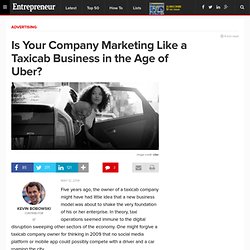
In theory, taxi operations seemed immune to the digital disruption sweeping other sectors of the economy. One might forgive a taxicab company owner for thinking in 2009 that no social media platform or mobile app could possibly compete with a driver and a car roaming the city. But, of course, he or she would have been wildly wrong. When Uber cropped up and connected drivers with ride-seekers, digital platforms had unlocked a powerful sharing economy that changed the way consumers viewed taxis, hotel bookings, hiring practices and even dog sitting.
Marketers today are the taxicab companies of 2009. Related: 5 Ways to Harness Hashtags to Drive Business Value The smartphone-powered creative department. Adidas privilégie la qualité à la quantité durant la coupe du monde de Football. How to capture the attention of your target demographic at a highly important but ‘noisy’ time?
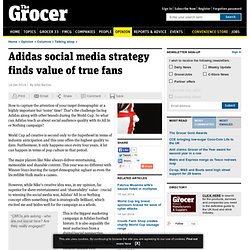
That’s the challenge facing Adidas along with other brands during the World Cup. So what can Adidas teach us about social audience quality with its All In or Nothing campaign? World Cup ad creative is second only to the Superbowl in terms of industry anticipation and this year offers the highest quality to date. Furthermore, it only happens once every four years. A lot can happen in terms of pop culture in that period. The major players like Nike always deliver entertaining, memorable and sharable content. However, while Nike’s creative idea was, in my opinion, far superior for sheer entertainment and ‘shareability’ value - crucial to winning the social media war, Adidas’ All In or Nothing concept offers something that is strategically brilliant, which excited me and bodes well for the campaign as a whole. Attention aux objectifs irréalistes (article sur le faible trafic généré par les RS) Social networks drive 7.7% of visits to retail web sites. Shoppers are increasingly clicking from social networks to retailers’ web sites because consumers are using sites like Facebook and Pinterest to discover products, according to a new report from Experian Marketing Services.

Shoppers clicking from social networks today account for 7.7% of all traffic to retail web sites in November, the report found, up from 6.6% a year earlier. Experian says it collects data on more than 34,000 retailers' web sites. Et attention à l'illusion du gratuit ! > Marketing for The Age of The Network Effect. Sangeet Paul Choudary is the author of the blog Platform Thinking.
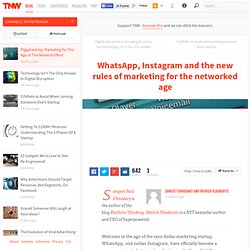
Patrick Vlaskovits is a NYT bestseller author and CEO of Superpowered. Welcome to the age of the zero-dollar marketing startup. WhatsApp, and earlier Instagram, have officially become a permanent part of startup lore for having built multi-billion dollar businesses without (reportedly) spending a dime on marketing. Meanwhile, Airbnb has grown from a hipster community of mattress-renters to the world’s largest provider of accommodations without spending even a fraction of what traditional hotel chains spend in marketing.
Marketing is dead! Well… not quite! The fastest growing networks on the internet – Airbnb, Instagram, Facebook, YouTube, Snapchat – may not have spent much on marketing, but they all have one thing in common: Each of these networks piggybacked on top of another pre-existing network. Facebook and Bebo grew on top of the network embedded in our email. L'engagement des visiteurs directs sur les sites d'infos plus fort que via Facebook ou Google. D’après une étude du Pew Research Center, les visiteurs qui accèdent directement aux sites web sont bien plus engagés que ceux qui y accèdent grâce aux réseaux sociaux (Facebook Referals) ou aux moteurs de recherche (Search engine referrals).

Même si ces deux derniers sont indispensables pour faire connaître les sites d’informations en ligne, les visiteurs réguliers qui accèdent directement aux sites (en tapant l’adresse ou grâce à un lien enregistré) sont ceux qui ont une réelle valeur pour les sites publiant du contenu. A New Social Contract. Let's pour out a 2-liter Pepsi for Papa John's.
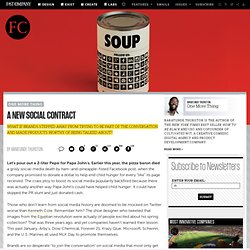
Earlier this year, the pizza baron died a grisly social-media death by ham-and-pineapple-fisted Facebook post, when the company promised to donate a dollar to help end child hunger for every "like" its page received. The crass ploy to boost its social media popularity backfired because there was actually another way Papa John's could have helped child hunger: It could have skipped the PR stunt and just donated cash. Those who don't learn from social media history are doomed to be mocked on Twitter worse than Kenneth Cole. Remember him? The shoe designer who tweeted that images from the Egyptian revolution were actually of people excited about his spring collection?
Article : Les stratégies du dernier clic ne sont plus adpatées aux parcours des internautes. Last-click attribution models are no longer fit for purpose in today’s data-driven digital world, so marketers need to get creative to ensure new models are agile and adaptable for a new era Attributing a sale to a particular piece of marketing has long been a headache for brands – one that increases proportionally with the growing number of marketing channels and technology platforms they use to reach their audience.
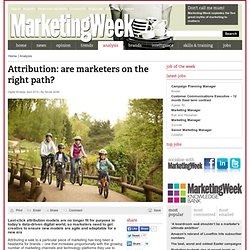
But current models of attribution are so unfit for purpose that at the Advertising Research Foundation’s Re:Think conference in New York last month, Facebook vice-president of global marketing solutions Carolyn Everson proclaimed that marketing needs “new measurement for a new era”, in order to cope with consumers’ behaviour across all kinds of connected devices. One driving force for change is the divisive nature of last-click data. Others are also moving away from the last-click model. House of Fraser’s measurement hub assesses display ad effectiveness Viewpoint. La désillusion d’une mauvaise stratégie sur les médias sociaux.
Facebook va-t-il chuter ces prochains mois de son piédestal ?

Résumé : Aujourd’hui, toutes les entreprises ont compris que être présent seulement sur Facebook ne pouvait pas être une stratégie viable sur les médias sociaux. Que les objectifs soit centrés autour de la marque (notoriété, trafic sur un site, proximité, attractivité…) ou du client (acquisition, fidélisation, satisfaction client, engagement client…), il convient de définir une stratégie efficace et adaptée.
Efficace et adaptée signifie en cohérence avec la stratégie globale de l’entreprise et avec les attentes des internautes (ou plus précisément des cibles visées sur Internet).